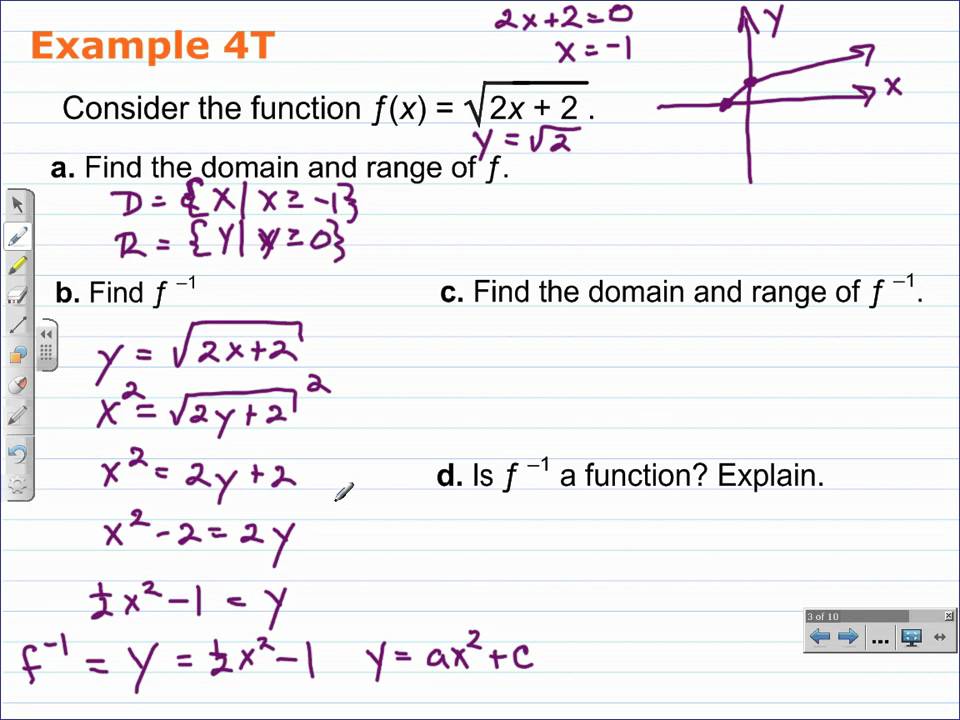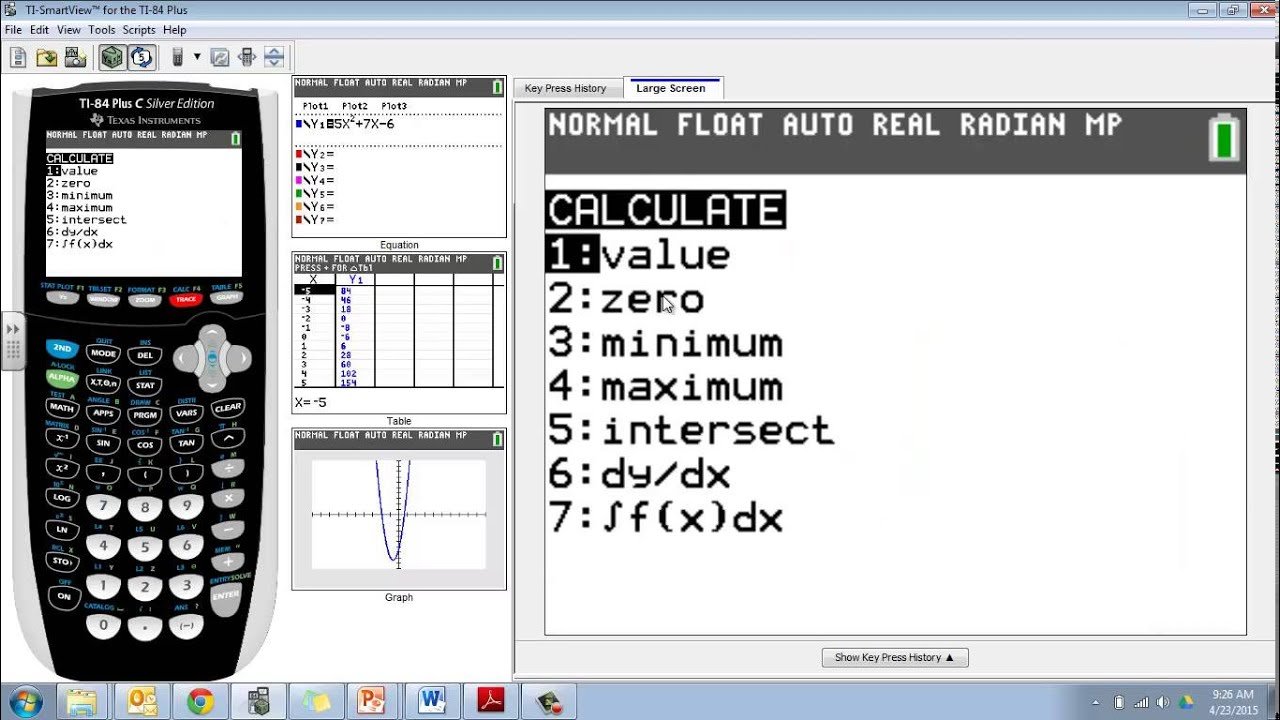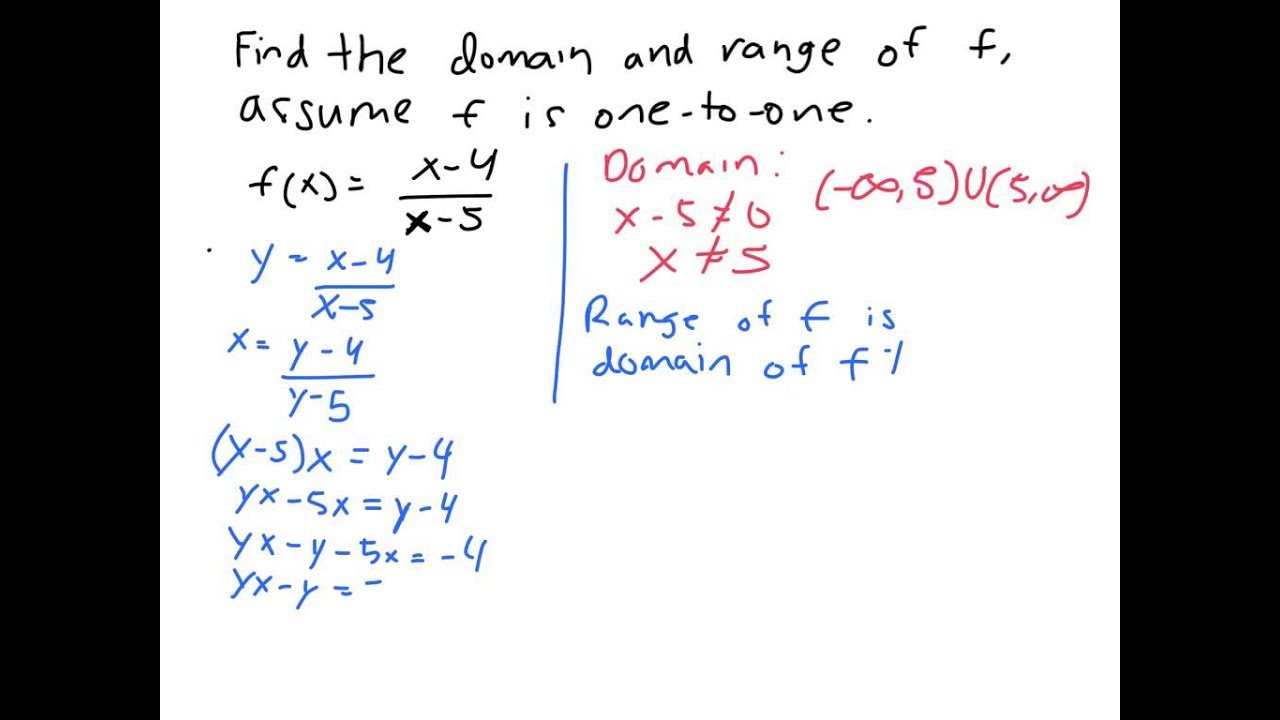Find Domain Of A Logarithmic Function
From Rule 7 we know that a Logarithmic Function of the form f=\ln \left \right ) is defined when g> 0.
Example:
The function f= \ln is defined when
x-2> 0
Therefore f= \ln is defined for all x> 2.
\therefore domain of f= \ln is
D = :x> 2} =
Example:
f= \ln
Solution:
The function f= \ln is defined when
x^-3x+2> 0
i.e., > 0
| > 0 satisfied or not |
|---|
| x=.5< 1 |
i.e., x< 1 and x> 2
\therefore domain of the function f= \ln is
D = :x< 1,x> 2} = \cup
Finding Domain Of A Function With A Square Root In The Numerator And Denominator
From Rule 6 we know that a function of the form f=\sqrt} is defined when g\geq0 and h> 0.
Example:
f=\sqrt}
Solution:
For f to be defined,
3-x\neq 0
Now we have to find the set of values of x so that
\frac\geq 0
Here we can not directly say x-2> 0 because we do not know the sign of 3-x.
To overcome this problem we will make the denominator +ve by multiplying the numerator and denominator by
i.e., \frac}\geq 0
i.e., \geq 0
Next we have to find the values of x so that \geq 0
Now see the table given below:
| Value of x | \geq 0 satisfied or not | ||
|---|---|---|---|
| x=0 | |||
| i.e., x\epsilon | +ve | i.e., -ve |
Now putting the signs on real axis for each interval and value of x, we get
\therefore the domain of the function f=\sqrt} is D = [2,3)
How Do You Find The Domain And Range On A Graph
If you are trying to find a range and range on a chart, the range is found by looking at the chart from left to right. You can find the area by looking at the diagram from top to bottom. Determine the scope and scope of these functions. View the graph from left to right.
How do you find the domain on a graph
Read Also: What Is The Io Domain Used For
How To Find The Domain And Range Of A Graph
- Draw a graph of f
- In any graph, they can have domain if all x coordinate values of the graph.
- And the range includes all y coordinate values of the chart.
- Finally, they should include/exclude endpoints in the interval by looking closely at the graph is a valid function).
Find Domain And Range Of A Function Calculatorw Find the range and range of multifunction functions with my TI84 calculator? 3I drew but can I find the domain and range from my computer? My answer should be in the interval indicator. And the example problem is y = 4xComputer does not report domain and area. Is there an indefinite x value for y? If y = 4 x 2 is not the answer, then real numbers consist of real numbers . Is the function limited to something? No, the function
How To Find The Domain And Range Of A Function Algebraically

Let the function be y=f. Let us find the domain and range of this function algebraically.
To calculate the domain of the function, we simply solve the equation to determine the values of the independent variable x. To calculate the range of the function, we simply express x as x = g and then find the domain of g.
Read Also: Godaddy And Squarespace
What Is The Domain Codomain And Range Of A Function
The set of elements in \ that are plugged into the function \ is called the domain.
The set \ that is a collection of possible outcomes is called the codomain. The set of images of the elements in \, which is a subset of \ is called the range of the function \
Range \
For the function \
Domain \
Codomain \
Range \
A Graphical View Of A Codomain
The image below summarizes the relationship between a domain, co-domain, and range.
- The red oval is the domain. Every input for the function f is a member of this domain and can be represented by x.
- The blue oval is the codomain. This represents every possible number that the output could take on. Every instance of the domain is mapped by the function f into this codomain.
- The yellow oval, a subset of this target domain, is the range and contains every actual instance of f.
Read Also: How Much Is A Domain Name Per Year
What Is The Range Of The Function On The Graph
- The easiest way to find the range of a function is to graph a graph and find the y-values the graph occupies.
- In the case of a square root function an absolute value function, the range is always y and
- To find the power of a quadratic function, just see if it has a maximum or minimum value.
What Is Domain And Range
The domain of a function, , is most commonly defined as the set of values for which a function is defined. For example, a function that is defined for real values in has domain , and is sometimes said to be “a function over the reals.” The set of values to which is sent by the function is called the range.
Informally, if a function is defined on some set, then we call that set the domain. The values taken by the function are collectively referred to as the range. For example, the function takes the reals to the non-negative reals . The sine function takes the reals to the closed interval .
- English
Read Also: How To See Who Owns A Domain Name
Target Sets And Composition
Target sets become crucial when we begin to start discussing compositions of functions. The composition fg is read f of g or f following g, and is a composite function that involves taking a member of the domain of g, sending it through the function g, and putting that output through f.
A composition is valid if and only if the co-domain of the second function is the same as the domain of the first function. In our example, the composition is only valid if the codomain of g is the same as the domain of f.
How Do You Determine The Domain Of A Function
The domain and scope of a role refers to the values in which that role exists. In a compound function, one function is applied to another. You need to find values for which the first function does not exist and values for which the first function returns values for which the second function does not exist.
Also Check: How To Determine Who Owns A Domain
Find The Domain And Range From Graphs
We know that the domain of a function is the set of all input values. So, the domain on a graph is all the input values shown on the \-axis. To find the domain, we need to analyse how the graph looks like horizontally. Moving from left to right along the \-axis, identify the span of values for which the function is defined.
Similarly, the range of a function is the set of all output values. On a graph, this is identified as the values that are taken by the dependent variable \. So, to find the range, look at the set of values that the graph spreads vertically.
Consider the graph of the function \.
Looking at the horizontal and vertical spread of the graph, the domain, and the range can be calculated as shown below.
The closed points on either end of the graph indicate that they are also part of the graph. Therefore, the domain is \ and the range is \.
Now, if you have open points instead, the function is not defined at that point.
Here, the domain is \ and the range is \. Note that, here the value \ is included in the range as it already has a pre-image at \ and \
Sometimes the graph continues beyond the portion shown. In such cases, the domain and range could be greater than the visible values.
Generally, the arrows on either end show that the graph extends infinitely in both directions, and hence, the domain is the set of all real numbers. However, the range in this particular case remains the same as \
Finding The Domain Of A Function Using A Graph

Read Also: What Is The Io Domain Used For
What Is A Codomain
A codomain contains all values of a function.
When we say that a function f: X Y, the codomain is the Y. In other words, the output from a function is constrained to the codomain.
The range is similar, but the difference is that a range is the set of the actual values of the function . A codomain or target set can contain every possible output, not just those that actually appear. For example, you might specify that a codomain is the set of all real numbers . However, that doesnt mean that all real numbers are outputs for your function.
Which Best Describes The Range Of A Function
The functional area is the set of all possible inputs, since it contains all the x values that make the function work, and the real y values yield 13 votes. Offer!
Graphing absolute value functionsHow do you graph the absolute value function? An absolute value function is a function whose line contains an absolute value expression. To plot the absolute value function, select multiple values of x and generate ordered pairs. Have your students fill in the values of x into the equation and solve for the values of y . Then draw poin
Recommended Reading: How To Sell Your Domain Name
What Is The Difference Between Domain And Range
- Scope and scope are the main factors determining the applicability of mathematical functions.
- The domain is the independent variable and the area is the dependent variable.
- The variable on the X-axis is the area and the variable on the Y-axis is the range.
- A domain is also defined as the collection of all possible input values.
How To Find The Domain And Range Of A Function
This article was co-authored by our trained team of editors and researchers who validated it for accuracy and comprehensiveness. wikiHow’s Content Management Team carefully monitors the work from our editorial staff to ensure that each article is backed by trusted research and meets our high quality standards. This article has been viewed 153,221 times.Learn more…
Every function contains two types of variables: independent variables and dependent variables, whose values literally depend on the independent variables. For example, in the function y = f = 2x + y, x is independent and y is dependent . The valid values for a given independent variable x are collectively called the domain. The valid values for a given dependent variable y are collectively called the range.XResearch source
Recommended Reading: How To Get A .io Domain
How To Graph On Desmos
- When creating a table in Desmos, the dots can be connected by long clicking on the icon next to the dependent column header.
- This screencast was made with Doceri on an iPad.
- Another way to create a moving point is to enter a point with a parameter for one or both coordinates.
Function table calculatorHow do you find the values of a function? Follow these steps to find the value of a function using the calculator: Enter the function in the Y= editor. Press to go to the main screen. Press to enter the YVAR menu and select the desired function. Press and enter the x value you want to evaluate, press and then press .How do you calculate the graph of a function?Define the graph of the function. The graph of the function f
Wolframalpha Online Domain And Range Calculator
This is perhaps the best online calculator for finding the domain and range of a function easily. Open the dedicated webpage and just enter your query in the search box. Then click the equals sign in the search bar to get the domain and range values.
WolframAlpha also offers an extended calculator with all the necessary symbols to make entering values easy. With the Pro version of this software, you can also download the page with full results as a static document for offline use.
You May Like: How Much To Purchase A Domain Name
How Do You Find The Range Of A Square Root Function
How to find the area of a square root function. The simple function y = f contains an independent variable x and a dependent variable y . The possible values of x are called the functional region. The possible values of y are the range of functions. The square root y of x is the number with y^2 = x.
Closed Domain In Other Contexts

In artificial intelligence, closed domain refers to a situation specific system in question answering . For example, a system called AIRPLANE might be good at answering questions about air speed, acceleration and capacity of specific aircraft, it isnt very good beyond that specific area. An open-domain QA on the other hand, is able to sift through an unlimited domain to find the answer to a question.
In software engineering, a closed domain is simply a domain where all boundaries are closed. An open domain is one where all boundaries are open.
Integrally closed domains are found in commutative algebra. An integrally closed domain A is an integral domain whose integral closure in its field of fractions is A itself.
Also Check: How To Transfer Squarespace Domain To Godaddy
Domain And Range Of Exponential Functions
The function y = ax, a 0 is defined for all real numbers. Hence, the domain of the exponential function is the entire real line. The exponential function always results in a positive value. Thus, the range of the exponential function is of the form y= |ax+b| is y R , . Domain = R, Range =
Example: Look at the graph of this function f: 2x
Observe that the value of the function is closer to 0 as x tends to but it will never attain the value 0. The domain and range of an exponential function are given as follows:
- Domain: The domain of the function is the set R.
- Range: The exponential function always results in positive real values.